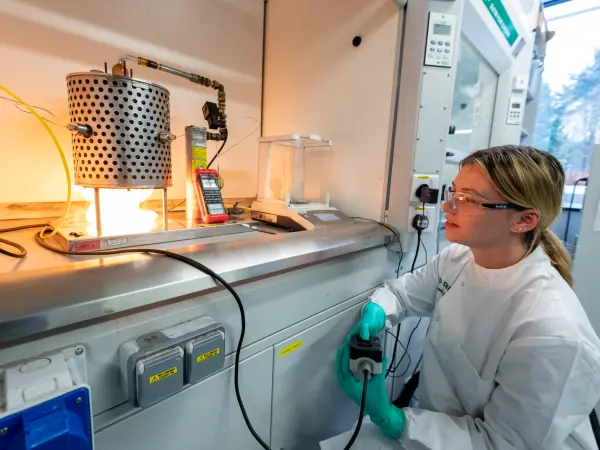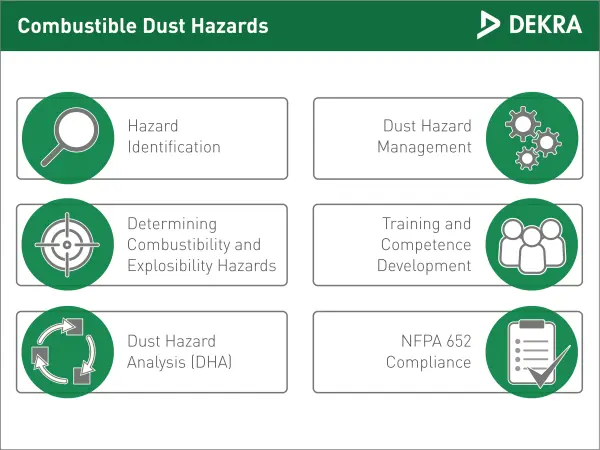
DEKRA Advisory & Training
Working safely with combustible substances? Discover how our DEKRA experts can assist you.

DEKRA Advisory & Training
Working safely with combustible substances? Discover how our DEKRA experts can assist you.
Combustible Dust Hazards
Know your risk to prevent dust explosions with the help of our combustible dust services
Organizations that are aware of the hazards of combustible dusts and how to manage or eliminate the dangers they pose can effectively avoid the catastrophic effects of dust explosions: loss of life and property, injury, damages, interrupted production, litigation and adverse publicity. Unfortunately, these incidents occur all too frequently, indicating a lack of sensitivity to the topic and perhaps a lack of access to appropriate expertise.

Our engineers have a strong background in combustible dust issues, strengthened through years of experience. We offer a comprehensive package of services, helping you to identify hazardous materials and to assess associated risks. Testing, which we carry out in our own state-of-the-art laboratories, is a start, but interpreting the data and translating our findings into practical solutions through expert advice is our strength. Whether advising you on the choice and design of explosion protection systems, performing risk assessments or recommending training, we never lose sight of the big picture: a safe and secure working environment within a thriving organization.
Your Benefits
- Safe and secure working environment
- Comprehensive service package for the identification of hazardous substances
- Expert knowledge in the field of combustible dust
- Practical solutions through advice
Our Approach
Our portfolio of services related to combustible dusts reflects our comprehensive approach to safety, encompassing advice, training and testing. We offer expertise in:
- Hazard Identification
- Determining Combustibility and Explosibility Hazards
- Dust Hazard Analysis (DHA)
- Dust Hazard Management
- Training and Competence Development
- NFPA 652 Compliance

One of our teams can help you select the most appropriate tests and the most cost-effective manner to respond to your needs. The tests we offer include:
Dust Explosion Screening
- Group Go/NoGo Classification determines whether a powder or dust is explosible (Type Go) or non-explosible (Type No Go) when exposed to an ignition source when in the form of a dust cloud.
Ignition Sensitivity
- Minimum Ignition Energy (MIE):determines the minimum energy of an electrostatic or mechanical spark capable of igniting dispersed dust under ambient conditions.
- Minimum Ignition Temperature (Cloud): determines the minimum temperature of a hot surface capable of igniting a dust cloud.
- Minimum Ignition Temperature Layer (MIT Layer): determines the minimum temperature of a hot surface capable of igniting a powder layer (5 mm in depth).
Flammable Limits
- Limiting Oxygen Concentration (LOC): determines the highest oxygen concentration at which ignition of dispersed dust at ambient temperature and pressure is not possible.
- Minimum Explosible Concentration (MEC): determines the minimum concentration of a dust at which ignition is possible.
Explosion Severity
- Dust Explosion Severity: measures a powder’s explosion severity according to specific pressure parameters
Why DEKRA?
- We have a global company with extensive knowledge and resources.
- We have become the first choice for companies looking for a reliable partner to deal with process safety issues in general and the challenges of combustible dust in particular.
- We have ISO 9001 accredited and GLP (Good Laboratory Practice) approved laboratories.
- We are process safety experts and support you with the highest qualifications, experience and a real passion for teamwork in developing sustainable safety solutions.
Q: What types of materials qualify as combustible dusts?
A: More than 70% of powders handled in industry are recognized as flammable. Processing powdered sugar, flour, aluminum powder and even aspirin can create significant risk of fire and explosion, and this can occur when the substance is in the form of a layer of powder, a cloud of dust or during decomposition. Of course, there are other sources of combustible dust and new materials are constantly being developed that require testing, but it is important to realize that even substances that are not normally associated with flammability or explosivity can indeed cause disastrous incidents. These materials are made more dangerous by the lack of awareness surrounding them.
Q: What causes a dust or powder to ignite or explode?
Q: How can I get started with confronting these dust hazards?
Q: What are some of the measures that make up a “Basis of Safety”?
Q: What sort of testing is required?
Q: How can DEKRA Process Safety help?
Process Safety
+31 10 21 61 144
process-safety.nl@dekra.com